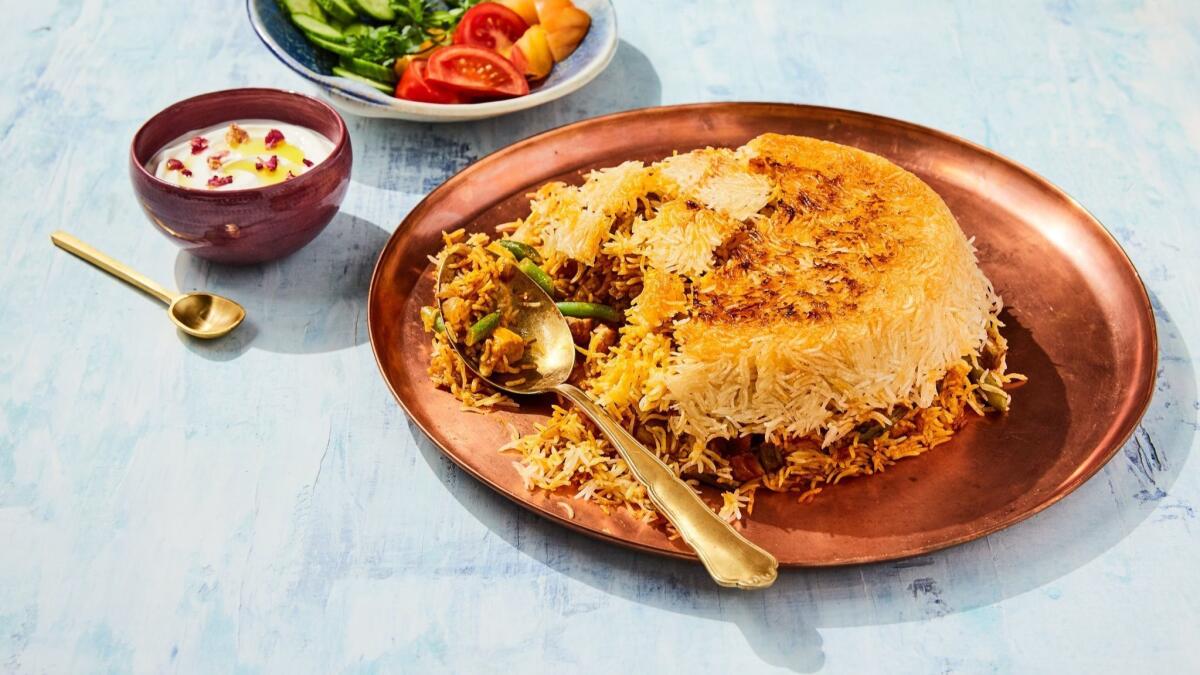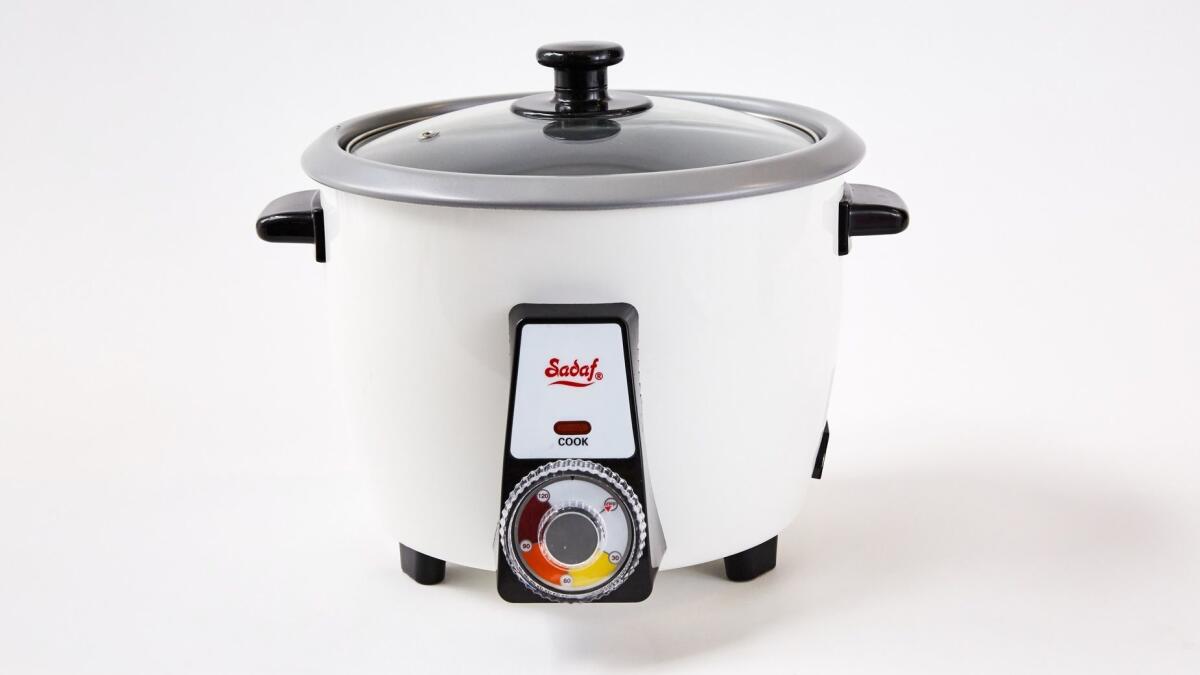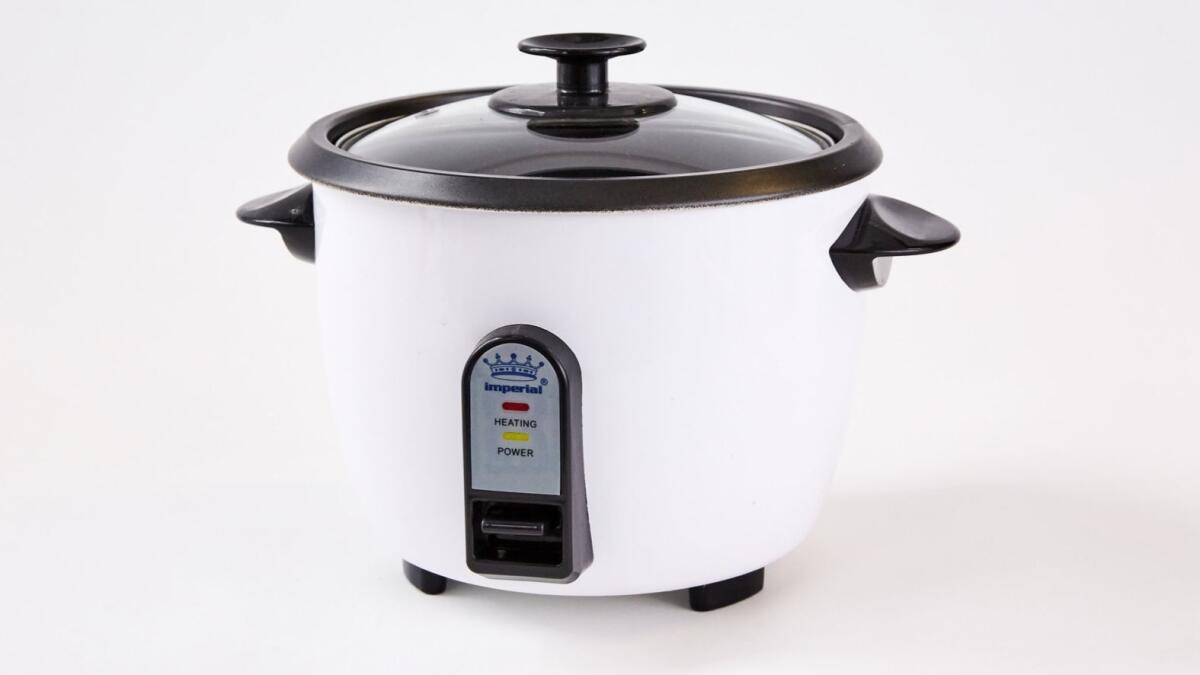The secret (OK, shortcut) to perfect tahdig

- Share via
Tahdig is a Persian showpiece dish: the inverted contents of a pot or pan of rice, the bottom of which is expertly cooked until it is crisp and burnished and crackles when you cut into the pilaf with a spoon. My friend Dorna Khazeni once gave me a tahdig lesson, one that involved a lot of soaking rice, rinsing rice, salting water, boiling rice, agitating the pot, flipping the pot upside down and some other things I don’t quite remember.
On my own, my version wasn’t a disaster, but it wasn’t a culinary triumph either. I couldn’t attain the right color of orange-gold on the underside that, once flipped and served, is the top part, and the white rice beneath the strata of crust was a little soft, not the elegant individual strands that I’d hoped for.
Then a few months ago, Dorna returned from visiting family in Tehran. She told me that her father, shocked that she was still cooking tahdig the old-school way, insisted she purchase a “polo paz,” or a Persian rice cooker. Reluctantly, Dorna bought one. She soon became a convert. Well, a semi-convert.
Dorna, who works as a translator and interpreter for the likes of French author Michel Houellebecq and Oscar-winning Iranian filmmaker Asghar Farhadi, could now start soaking her long-grain basmati rice before she left for work, have tahdig on the dinner table within 90 minutes of arriving home, and be left with just one pot to wash. But as much as she loved the expediency, she was still torn: She missed the breath-holding trickiness of making tahdig on the stove. She also wasn’t sold on the end result. “It isn’t as nice as what you make when you’re going through all those steps,” she said.
As it turns out, this conflict of tradition versus convenience is as old as the Persian rice cooker itself, which dates back to the 1960s. That’s when the folks at Toshiba realized that by coating the interior pot with a smooth, non-stick surface and modifying the self-monitoring thermal sensor in the base that knows when to switch from cooking to “keep warm,” they’d transformed their Japanese rice cooker into a tahdig maker.
Pars Khazar, an Iranian-based small appliance maker, was the first to partner with Toshiba. Soon an entire industry was born, represented now by more than eight brands on the market, and a raging debate on the internet about which is best.
Parisa Amini of Persian Basket, online company that sells Persian food and kitchen equipment from Atlanta, including three types of rice cookers, says that the discourse is largely over design.
“Some people say, ‘This one reminds me of back home when I was a little kid,’ other ones are more modern-looking,” Amini said. “But as a distributor of Persian rice cookers, I can say that functionality-wise, they’re pretty much all the same.”
She added that the company’s target audience for rice cookers is “the younger generation because they aren’t interested in cooking and it’s the quickest and most dummy-proof way of making rice.”
When I mentioned that an estimated 85% of households in Tehran have a rice cooker on their kitchen counter, that they’re so popular that a man in Tehran’s Grand Bazaar specializes in re-coating the Teflon on worn-out pots, she explained that cookers are for immediate-family-use only.
Stove-top tahdig and cooker tahdig are different enough in quality that you’d never serve the latter to a guest, she explained, that it would indicate that you didn’t care and that by simply pressing the “on” button and walking away, you were willing to “cheat the system.”
But she offered me a sort of cultural loophole: If I, an American, was married to an Iranian man, my making tahdig in an automatic cooker for his visiting family would qualify as the height of hospitality. “The Iranian guests would be impressed,” she said, before adding this not-so-subtle asterisk, “Americans don’t like to cook rice, and especially not in the traditional way.”
Persian rice cookers aren’t magic one-touch devices. The booklets that come with the appliances are pretty thin on the particulars. You are still left with questions: How much rice to how much water? How long do I wait before adding oil? In the end, it took a village: Dorna told me to mix in a tablespoon of saffron-infused yogurt to give the tahdig a thicker, cakier texture.
Najmieh Batmanglij, author of “Food of Life: Ancient Persian and Modern Iranian Cooking and Ceremonies,” advised me to use a standard measuring cup for the water and rice, not the small plastic one that comes with the cooker. It was a man at my local beauty supply store — don’t ask how we landed on the topic — who reminded me to wrap the lid in a dish towel, weigh it down with a heavy bowl, and cook for up to 90 minutes.
I kept all these details in mind when I made my first rice cooker tahdig. An hour and a half later, I nervously placed a dish on the top of the interior pot and turned it upside down. Out slid a crunchy medallion of caramelized rice, the color of burnished pumpkin. The grains were fluffy and unbroken, and I could tell that when I cut into the tahdig, there’d be an audible crackle. On a whim, I decided to pack it up, take it over to a friend’s house and put it on the dinner table. It wasn’t Instagram-perfect. It might not have passed muster with an Iranian grandmother. But it was gone in a breath.

So, you’re ready to try a Persian rice cooker
Most Persian markets in Los Angeles sell at least a couple of styles (so do Amazon and Persianbasket.com). Here are some options:
My most successful attempts were made in a 5-cup Imperial Rice Cooker. A stripped-down model is available on Persian Basket for about $49.
At $55 for a 5-cup cooker, Pars, which is controlled by a color-coded timer, is considered the most popular brand.
The more affordable Sadaf’s 6-cup cooker, a sturdy, basic style, can be purchased in store or from its website for about $39. Mona Soofer, head of marketing at Sadaf, says she uses hers not just for rice, but for steaming vegetables and making spaghetti tahdig, a crusty, one-pot Persian take on Italian pasta.

Once you’ve purchased the rice cooker, what’s the best way to make basic rice in it?
Naz Deravian, the Iranian-born and Los Angeles-based author of “Bottom of the Pot: Persian Recipes and Stories,” says there isn’t one. “Every home has their own way and each will tell you that their way is best,” says Deravian, adding that her personal technique is to put rice, water, oil and salt in the cooker, give it a gentle stir, put the lid on and wait for the timer to ding. “For me, the point of the Persian rice cooker is for a Wednesday night meal where we all crash into the house and it’s something we can make easily.”
When it comes to care and maintenance, Deravian says it’s essential to treat the non-stick pot lovingly. “I never go at it with a metal utensil, and my husband and I don’t let anyone else wash it,” she says. If grains of rice get stuck in scratches that form on the Teflon surface, the tahdig can crack. It’ll still taste good, but that will ruin the presentational “wow” moment at mealtime. “I grew up in the West,” Deravian says. “My friends are mostly not Iranians. And when I flip that rice pot? Everybody just loses their minds.”
More to Read
Eat your way across L.A.
Get our weekly Tasting Notes newsletter for reviews, news and more.
You may occasionally receive promotional content from the Los Angeles Times.
![LOS ANGELES, CA - JUNE 17: [Cody Ma and Misha Sesar share a few dishes from their Persian Restaurant Azizam] on Monday, June 17, 2024 in Los Angeles, CA. (Ethan Benavidez / For The Times)](https://ca-times.brightspotcdn.com/dims4/default/7ffc7f6/2147483647/strip/true/crop/5110x3417+306+0/resize/320x214!/quality/75/?url=https%3A%2F%2Fcalifornia-times-brightspot.s3.amazonaws.com%2F79%2Fdc%2F4d29255545f5b9813315901692bc%2F1459972-fo-azizam-review20-eba.JPG)









